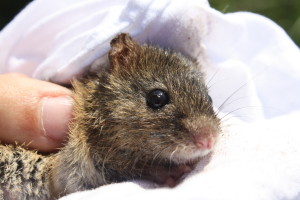
I’m curious why this marsh rice rat was the only one caught that day, while house mice were abundant
As you might expect after looking through my blog posts from this month, I found a pretty distinct dichotomy in terms of conservation programs that deal with rodents: some projects are trying to get rid of them, and others are trying to protect them. Either way, there are a variety of options for us in terms of helping out, and I also stumbled across a general citizen-scientist opportunity for those of us who like looking at pictures of wildlife.
Looking to help remove invasive species and protect native wildlife?
- The Galapagos Conservancy has been working to eradicate invasive rodents from the islands, one location at a time- you can make donations to support the program. Flora & Fauna International’s Offshore Islands Conservation Programme is another project you can support through donations.
- You can also adopt a bait station at the Te Kauri Lodge in New Zealand through their ‘Rat? Or Tui?’ program.
More interested in supporting the rodent populations at risk?
- If you live in a coastal area, several states have guidelines for protecting the habitat used by beach mice- Florida is one example.
- In the UK, the Wildlife Trusts has a number of projects which benefit local rodent species, including the water vole.
- The Lincoln Park Zoo has a Meadow Jumping Mouse Recovery project- the zoo has a variety of opportunities to support their work through volunteering, becoming a member, donating, and joining them in a marathon.
- By visiting the Prospect Park Zoo, you help support their conservation programs, such as breeding efforts for the giant jumping rat of Madagascar, and the same is true of the San Diego Zoo and the Pacific pocket mouse.
- The Australian Platypus Conservancy wants your help in locating water-rat populations.
- And if you are interested in starting a community-wide conservation initiative to help rodents (and other species), Wildlife Support and Conservation provides a really good example of that type of effort, including their interest in dormice and yellow-necked mice.
For those of us who simply enjoy looking at pictures of wildlife, whether or not they contain rodents, the Zoological Society of London’s Edge of Existence wants our help in identifying the species in wildlife camera pictures from around the world– it’s a great chance to see wildlife from a variety of countries and help scientists organize their data.
